Shane Flanagan returned home 13 months ago to take over the running of the herd from his father Martin Flanagan, a well-known Holstein breeder and Dovea Genetics breeding adviser.
The farm outside the town of Crossmolina, Co Mayo, works off a 20ha milking block and with acreage at a premium, high-yielding Holstein is the cow type of choice.
A hit with TB in 2020 saw cows being removed from the farm, which has also had a knock-on effect on replacements coming forward.
Herd size is sitting at 38 cows, while youngstock have been contract-reared off the farm for the past six years.
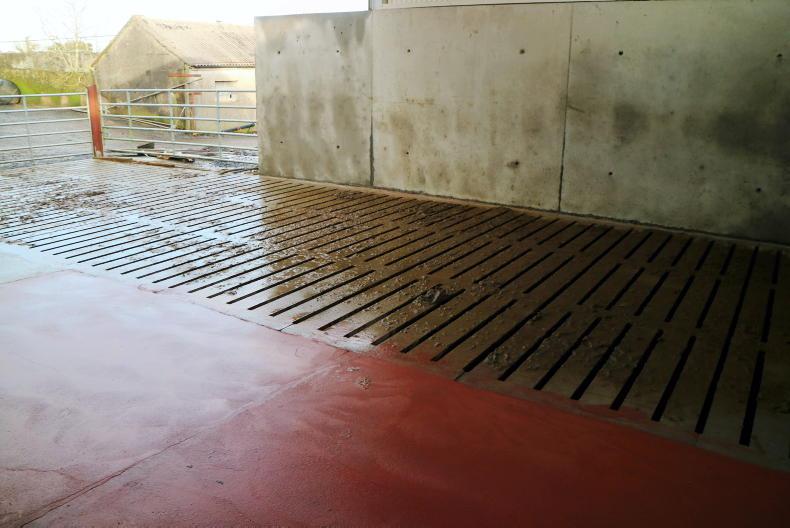
A 40ft x 13ft x 8ft dirty water storage tank was built at the bottom of the parlour, which functions as the collecting yard.
The plan for the farm is to build numbers up to 50 in the next two years, milking 60 in five years’ time at a stocking rate of 3 lu/ha with silage ground hopefully leased.
Investing in infrastructure
Having worked on farms with rotarys, double-up parlours and swingovers, Shane said it was very hard to come back to the five-unit Alfa Laval parlour that had been on the farm for 47 years. With Shane a qualified young farmer, having attended Kildalton College, he decided to apply for TAMS aid to construct a new parlour.
“I had talked to a lot of friends from Kildalton on parlour makes, and priced around a few suppliers when deciding on which brand to go for. For the technology that came with it, Pearson came in very competitively. What I liked about their parlour was the ability to add on extras in years to come.
“The TAMS reference cost is based off a very basic parlour, so budget dictated that I add these on in later years.
“Backup service was as important as the parlour itself, and Jarlath Colleran, the Pearson rep for the west, has a great reputation and has been very accommodating in the past and with the new build.’’
Shane also noted the quietness of the parlour, saying it was a pleasant parlour to milk in.
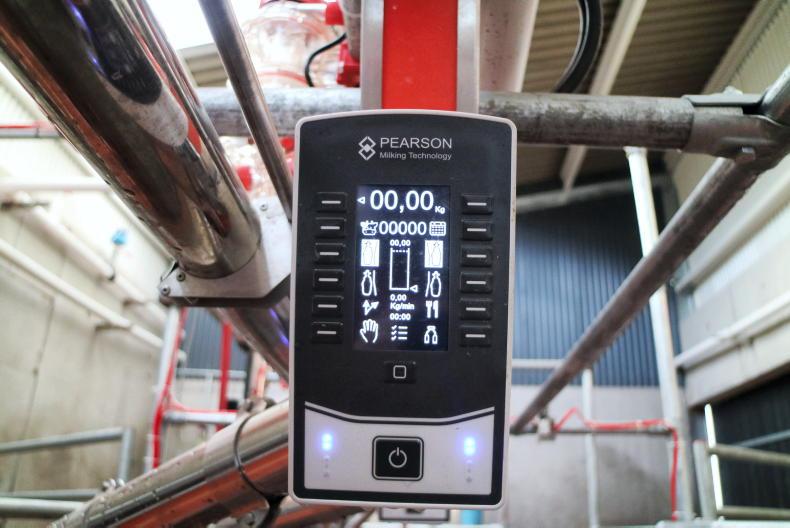
The Pearson P100 keypads allow for drafting from the pit to be installed at a later date, with Shane planning on fitting collars on cows.
Shane opted to install a 10-unit Pearson herringbone parlour, with room for and additional two units to be added. The new parlour was set parallel to the old unit, with plans to knock this building and install a covered handling area in the future.
The parlour
The holding yard at the back of the parlour is slatted, with a portion of this roofed. Space constraints dictated that the holding yard be at a right angle to the parlour.
The dirty water tank measures 40ft long by 13ft 6in wide, with a tank depth of 8ft, giving 122m³ of storage.
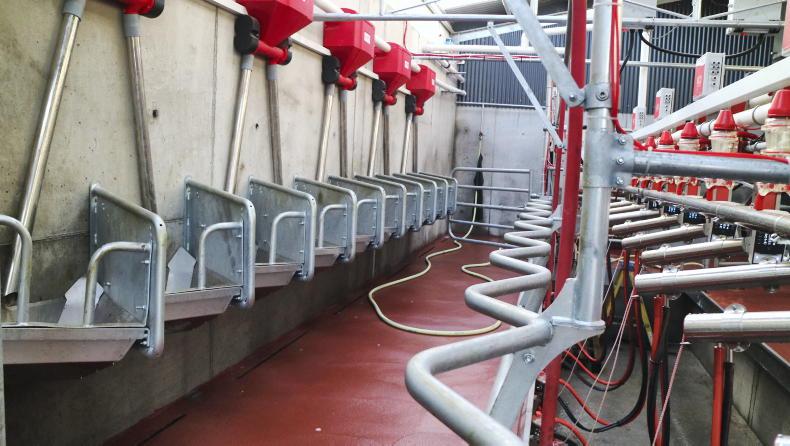
Rump rails and anti-bully bars were installed, with feed-to-yield an option going forward.
This gives Shane, based off a 60-cow herd with 30 litres washing/cow, 54 days of storage when a 20% buffer is taken in to account and rainwater is excluded, with Shane planning on roofing the rest of the collection yard in the future.
The Pearson parlour has 2x2 pulsation with a variable speed pump. Shane specified the parlour with automatic gates at the front and back, with automatic cluster (ACRs) removers also added.
Anti-bully bars were installed on the feed mangers, with rump rails installed to the rear. The parlour is set up for feed-to-yield through auto ID, which Shane noted as being important for a high-yielding, split-calving herd.
“I can have cows calved 10 months or freshly calved cows coming in beside each other, so I want to have that option,’’ said Shane.

A 40ft x 13ft x 8ft dirty water storage tank was built at the bottom of the parlour, which functions as the collecting yard.
Being a one-man operation, Shane intends to install an auto-drafting gate in the next two years, with the technology in the parlour facilitating this.
Dump lines and cluster flush are not fitted but can be easily installed afterwards. The clusters are a carbon-type unit, which are a lighter but equally strong cluster, with the idea being that a reduced weight cluster reduces wear and tear on the farmer and on the cow’s udder.
The computer fitted to each cluster is one of the first of a new model by Pearsons, with milk meters fitted and housing left to take a milk sample for milk recording.
The building itself is to TAMS spec, with the washings tank and all structural and concrete work supplied and installed by local company Merdoc Construction, with the structural steel and sheeting supplied by DG Roofing, WIlliamstown. All structural steel is galvanised, with Shane opting for cement fibre sheeting for longevity. Clear roof lights are fitted to allow natural light in and make the parlour a pleasant place to work in.
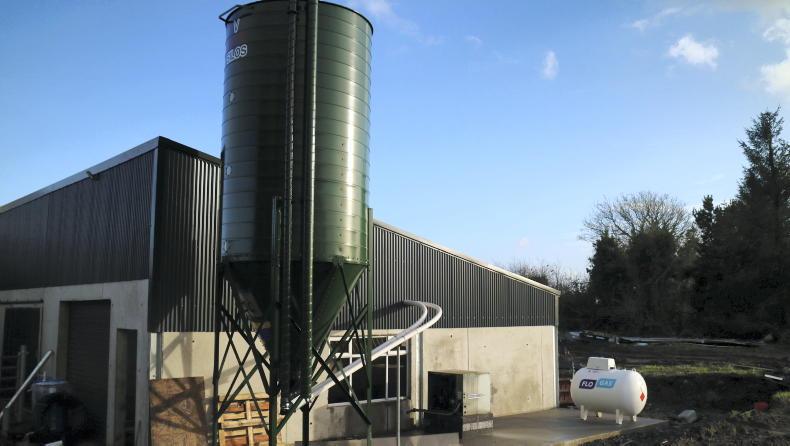
Shane opted for a new V-Mac 12 tonne meal bin, which was also eligible for grant aid.
The dairy and plant room are situated at the front of the parlour. A 5,080l Mueller tank that was installed in 2008 was reused and refitted by KK Refrigeration, based in Sligo, as it was in good working order, with a recent TBC reading of 10 with previous readings as low as four.
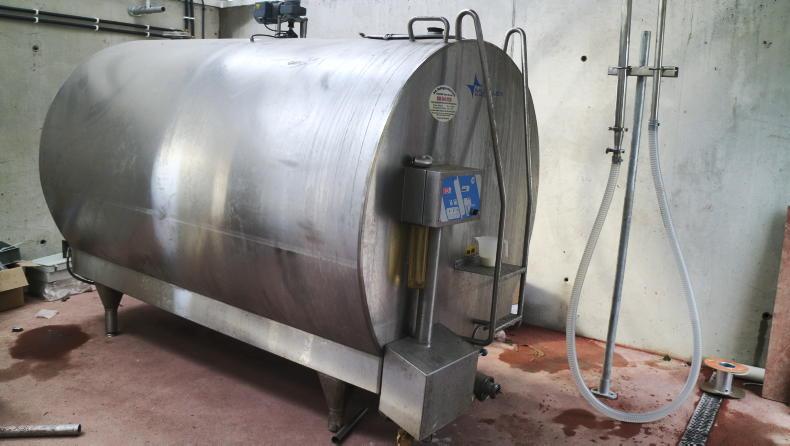
The 5,080 litre Mueller bulk tank was still in good working order so was reinstalled in to the new dairy.
Shane plans on using the tank for a number of years, before switching to a 7,500-litre tank when numbers are built up. Ample room has been left in the dairy for this, and the large plant room will be split to create an office space. A 12-tonne V-Mac meal bin has also been installed with grant aid. Milk cooling is through a plate cooler, with a gas heater installed for hot water to cut down on energy bills.
Some nice additions to the parlour are the slots cut in to the floor down in to a buried sewer pipe for dirty water collection.
Cost
Shane was keen to keep all business local, with many local tradesmen working on the project. Buildings costs rose slightly more than was planned due to inflation and extras added. Supply and fit of the shed structure and all concrete, including the concrete tank and slats, came to €87,800 + VAT. The parlour costs are broadly similar at €88,000, with other costs associated including the meal bin (€5,100 + VAT). Shane is set to claim back €29,000 in grant aid on the parlour and meal bin. Just shy of €8,000 was paid to E-Solutions, Crossmolina, for electrical work. Shane has yet to calculate the plumbing costs with some minor work to be completed.
Shane Flanagan returned home 13 months ago to take over the running of the herd from his father Martin Flanagan, a well-known Holstein breeder and Dovea Genetics breeding adviser.
The farm outside the town of Crossmolina, Co Mayo, works off a 20ha milking block and with acreage at a premium, high-yielding Holstein is the cow type of choice.
A hit with TB in 2020 saw cows being removed from the farm, which has also had a knock-on effect on replacements coming forward.
Herd size is sitting at 38 cows, while youngstock have been contract-reared off the farm for the past six years.

A 40ft x 13ft x 8ft dirty water storage tank was built at the bottom of the parlour, which functions as the collecting yard.
The plan for the farm is to build numbers up to 50 in the next two years, milking 60 in five years’ time at a stocking rate of 3 lu/ha with silage ground hopefully leased.
Investing in infrastructure
Having worked on farms with rotarys, double-up parlours and swingovers, Shane said it was very hard to come back to the five-unit Alfa Laval parlour that had been on the farm for 47 years. With Shane a qualified young farmer, having attended Kildalton College, he decided to apply for TAMS aid to construct a new parlour.
“I had talked to a lot of friends from Kildalton on parlour makes, and priced around a few suppliers when deciding on which brand to go for. For the technology that came with it, Pearson came in very competitively. What I liked about their parlour was the ability to add on extras in years to come.
“The TAMS reference cost is based off a very basic parlour, so budget dictated that I add these on in later years.
“Backup service was as important as the parlour itself, and Jarlath Colleran, the Pearson rep for the west, has a great reputation and has been very accommodating in the past and with the new build.’’
Shane also noted the quietness of the parlour, saying it was a pleasant parlour to milk in.

The Pearson P100 keypads allow for drafting from the pit to be installed at a later date, with Shane planning on fitting collars on cows.
Shane opted to install a 10-unit Pearson herringbone parlour, with room for and additional two units to be added. The new parlour was set parallel to the old unit, with plans to knock this building and install a covered handling area in the future.
The parlour
The holding yard at the back of the parlour is slatted, with a portion of this roofed. Space constraints dictated that the holding yard be at a right angle to the parlour.
The dirty water tank measures 40ft long by 13ft 6in wide, with a tank depth of 8ft, giving 122m³ of storage.

Rump rails and anti-bully bars were installed, with feed-to-yield an option going forward.
This gives Shane, based off a 60-cow herd with 30 litres washing/cow, 54 days of storage when a 20% buffer is taken in to account and rainwater is excluded, with Shane planning on roofing the rest of the collection yard in the future.
The Pearson parlour has 2x2 pulsation with a variable speed pump. Shane specified the parlour with automatic gates at the front and back, with automatic cluster (ACRs) removers also added.
Anti-bully bars were installed on the feed mangers, with rump rails installed to the rear. The parlour is set up for feed-to-yield through auto ID, which Shane noted as being important for a high-yielding, split-calving herd.
“I can have cows calved 10 months or freshly calved cows coming in beside each other, so I want to have that option,’’ said Shane.

A 40ft x 13ft x 8ft dirty water storage tank was built at the bottom of the parlour, which functions as the collecting yard.
Being a one-man operation, Shane intends to install an auto-drafting gate in the next two years, with the technology in the parlour facilitating this.
Dump lines and cluster flush are not fitted but can be easily installed afterwards. The clusters are a carbon-type unit, which are a lighter but equally strong cluster, with the idea being that a reduced weight cluster reduces wear and tear on the farmer and on the cow’s udder.
The computer fitted to each cluster is one of the first of a new model by Pearsons, with milk meters fitted and housing left to take a milk sample for milk recording.
The building itself is to TAMS spec, with the washings tank and all structural and concrete work supplied and installed by local company Merdoc Construction, with the structural steel and sheeting supplied by DG Roofing, WIlliamstown. All structural steel is galvanised, with Shane opting for cement fibre sheeting for longevity. Clear roof lights are fitted to allow natural light in and make the parlour a pleasant place to work in.

Shane opted for a new V-Mac 12 tonne meal bin, which was also eligible for grant aid.
The dairy and plant room are situated at the front of the parlour. A 5,080l Mueller tank that was installed in 2008 was reused and refitted by KK Refrigeration, based in Sligo, as it was in good working order, with a recent TBC reading of 10 with previous readings as low as four.

The 5,080 litre Mueller bulk tank was still in good working order so was reinstalled in to the new dairy.
Shane plans on using the tank for a number of years, before switching to a 7,500-litre tank when numbers are built up. Ample room has been left in the dairy for this, and the large plant room will be split to create an office space. A 12-tonne V-Mac meal bin has also been installed with grant aid. Milk cooling is through a plate cooler, with a gas heater installed for hot water to cut down on energy bills.
Some nice additions to the parlour are the slots cut in to the floor down in to a buried sewer pipe for dirty water collection.
Cost
Shane was keen to keep all business local, with many local tradesmen working on the project. Buildings costs rose slightly more than was planned due to inflation and extras added. Supply and fit of the shed structure and all concrete, including the concrete tank and slats, came to €87,800 + VAT. The parlour costs are broadly similar at €88,000, with other costs associated including the meal bin (€5,100 + VAT). Shane is set to claim back €29,000 in grant aid on the parlour and meal bin. Just shy of €8,000 was paid to E-Solutions, Crossmolina, for electrical work. Shane has yet to calculate the plumbing costs with some minor work to be completed.












 This is a subscriber-only article
This is a subscriber-only article








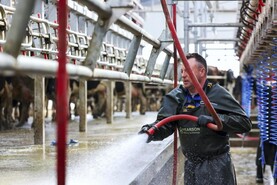

SHARING OPTIONS: